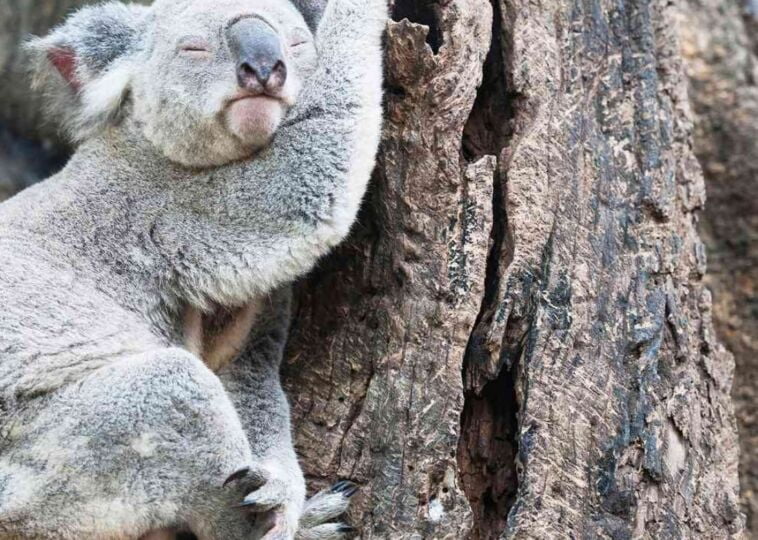Can’t Get Enough Sleep? See Which Animals Love it Most!

Contents [hide]
All crave a good night’s sleep to recharge after a long day, but did you know that some animals take this concept to a new level? Animals need their rest, and their sleep patterns can be astonishingly different.
From snuggly koalas to slumbering bats, sleep isn’t just about catching Z’s; it’s crucial for conserving energy, much like how we use our downtime to recharge. In the animal kingdom, the amount of sleep required varies widely based on diet, habitat, evolution, and survival needs. The variation in sleep among these animals can be attributed to their evolutionary adaptations.
Conversely, predators who need to stay alert and active might sleep less to be prepared for their next hunt. Sleep also helps maintain various bodily functions, including memory, energy conservation, and overall health. The balance between activity and rest is finely tuned to each species’ needs and lifestyle, illustrating how diverse the animal kingdom is.
Squirrel

Have you ever wondered what squirrels do when not darting around your yard, hoarding nuts, or chattering away? While these lively creatures might seem like they’re always on the go, they have a well-orchestrated sleep routine that helps them stay spry and alert. Tree squirrels are the quintessential nut hoarders you might spot darting from branch to branch.
They generally sleep in the safety of tree nests called drays, which they construct from twigs and leaves. These nests are cozy, high above the ground, offering protection from predators. Interestingly, grey squirrels, a common tree squirrel, have adapted to sleep primarily during the day.
They’re active at twilight and dawn, making several short naps throughout the day to stay alert for potential threats. When winter rolls around, squirrels face the challenge of staying warm. During this chilly season, they exhibit a behavior called torpor, a state of reduced metabolic rate that helps conserve energy.
Hedgehogs

If you’ve ever wondered why hedgehogs seem to be perpetually sleeping, you’re not alone. These adorable critters may have a reputation for being lazy, but the truth is that their extensive napping is vital for their health and survival. Hedgehogs are true night owls, or should we say night hedgehogs?
It’s not that they’re lazy; they’re wired to be most active when the sun goes away. Young hedgehogs are proliferating and need ample rest to support their development and energy needs. Like human babies, their bodies are rigid at work, even when dreaming. As winter rolls around, hedgehogs enter a state of hibernation.
During hibernation, hedgehogs lower their heart rate, body temperature, and respiration to conserve energy.
Tree Shrew

Tree shrews are small, nimble mammals that spend nearly two-thirds of their day asleep. Unlike many animals that are nocturnal or crepuscular, tree shrews are diurnal, meaning they are active during the day and tuck in for the night.
Their sleep schedule is quite the opposite of our typical 7-8 hour nightly rest; these little creatures sleep for extended periods, mainly at night when their vision is less effective. One of the most intriguing aspects of tree shrews is how their sleep patterns resemble those of humans.
While rodents often have fragmented and irregular sleep cycles, tree shrews exhibit consolidated sleep phases akin to ours. This means they enjoy longer, uninterrupted sleep periods, which are crucial for memory formation and overall well-being. Tree shrews’ ability to consolidate sleep could be linked to their evolutionary adaptations and their environment.
Owl Monkey

Owl monkeys, also known as night monkeys, are true nocturnes. Unlike most primates that thrive in the daylight, these unique creatures have adapted perfectly to life under the moonlight. Their large eyes, which give them their distinctive appearance, aren’t just for show; they are designed to maximize their vision in low-light conditions.
This night vision is crucial for their survival, allowing them to hunt and navigate the dense foliage of their rainforest home with remarkable agility. Their nightly adventures: Within 15 minutes of the sun dipping below the horizon, owl monkeys are already on the move. The owl monkey’s exceptional night vision is a double-edged sword.
While it allows them to be proficient hunters and adept survivors in the dark, it also makes them less suited to handle bright daylight. Habitat destruction and environmental changes impact their nocturnal lifestyle, making it increasingly difficult for them to thrive.
North American Opposum

Unlike those who are often on the go during the day, the North American opossum is a true night owl, or night marsupial, to be precise. This nocturnal animal is designed for nighttime activity, spending its days tucked away in cozy, safe spots while coming alive after dark.
Their schedule is finely tuned to avoid daytime predators and take advantage of nighttime foraging. They often find their way into deserted buildings or attics to escape human activity and other dangers. As a nocturnal creature, it’s evolved to be most active at night when it forages for food and explores its environment.
This nocturnal lifestyle requires that it avoid the dangers of the day by spending a substantial amount of time resting. Their preference for well-covered and secure resting spots is a smart survival strategy.
Python

Pythons are the ultimate night owls of the snake world, but their sleep habits and nocturnal lifestyle might surprise you. These fascinating reptiles have evolved to be masters of the dark, with their sleep patterns playing a crucial role in their survival. Let’s Pythons are predominantly nocturnal, meaning they’re most active after the sun goes down.
Their eyes are specially adapted to detect movement in low light, essential for hunting in the dark. Pythons retreat to dark, secluded daytime spots to protect their sensitive eyes from UV rays. Despite their reputation for being stealthy hunters, pythons are serious sleep enthusiasts.
Pythons have slow metabolisms, and their digestive processes can be energy-intensive, especially after a large meal. Sleeping for long stretches conserves the energy needed to digest their food correctly. Pythons’ sleep patterns are a bit of a mystery to researchers. While they are known to sleep for long periods, predicting their exact sleep schedule can be tricky.
Giant Armadillo

If you think you’re a champion sleeper, prepare to meet a true snooze superstar: the Giant Armadillo. Giant Armadillos are nocturnal mammals, which means their day is night. They’re most active just after sunset and before sunrise, transforming into nighttime adventurers. Instead, they spend about 18-20 hours snoozing, making their sleep patterns a study of extreme restfulness.
The extreme sleep duration of Giant Armadillos is closely tied to their nocturnal lifestyle and energy needs. Their diet consists mainly of insects and small invertebrates, which don’t yield high energy. To compensate, they must rest extensively to conserve energy for their nighttime activities.
Additionally, their slow metabolism and the need for energy conservation during the day contribute to their long sleep periods. The division between non-REM and REM sleep allows them to recuperate physically and mentally, maintaining their health and readiness for nocturnal foraging and exploration.
Brown Bat

Have you ever wondered how bats balance their nocturnal lifestyle with the need for energy conservation? Meet the Brown Bat, the most common bat species in the United States. These fascinating creatures have some of the animal kingdom’s most intriguing sleep and survival strategies.
Brown Bats are true night owls, emerging from their roosts at dusk to embark on their nightly foraging missions. Their nocturnal lifestyle is finely tuned to their need for constant energy replenishment. As winter approaches, Brown Bats prepare for hibernation, one of nature’s most remarkable survival strategies:
To make it through the cold months, they ramp up their food intake, storing up to 30% more body weight in fat. This extra layer of insulation and energy reserve is crucial for surviving the harsh conditions and prolonged inactivity that come with hibernation. Brown Bats enter a near-corporate state during hibernation, dramatically slowing their metabolism.
Sloth

Sloths, those irresistibly adorable creatures swinging through the lush canopies of Central and South America’s tropical forests, are more than just slow-motion marvels. Often mistaken for lazy loungers, sloths are fascinating animals with unique sleep habits and lifestyles.
Sloths are the epitome of slow living, spending most of their lives on treetops and blending seamlessly with their surroundings. You might think sloths spend their entire day napping, given their relaxed lifestyle, but here’s the scoop: they sleep up to 20 hours daily. Yes, you read that right, 20 hours.
They follow a sleep schedule of about 10 hours per night in their wild habitat, spread out over their slow-moving day. For sloths, sleep isn’t just a matter of relaxation; it’s a crucial part of their energy conservation strategy. This conservation extends into their sleep patterns, ensuring they are well-rested despite their seemingly minimal activity.
Koala

Beyond their fluffy exterior and those adorable, backward-facing pouches, koalas have some fascinating traits that explain why they spend 20 to 22 hours sleeping each day. Koalas call the eucalyptus forests of Queensland, Victoria, and a small part of South Australia their home.
By lounging high in the branches, koalas stay out of reach from most predators and enjoy an endless buffet of eucalyptus leaves. Koalas’ diet is deficient in calories and toxins due to the eucalyptus leaves they munch on. To break down these tough, fibrous leaves and neutralize the toxins, koalas require immense energy.
Their primary diet consists of eucalyptus leaves, which are hard to digest and contain toxins that need to be processed carefully. To deal with this energy challenge, koalas are often found in a deep slumber, conserving their energy for those brief but crucial hours awake. During their awake time, koalas are voracious eaters.


